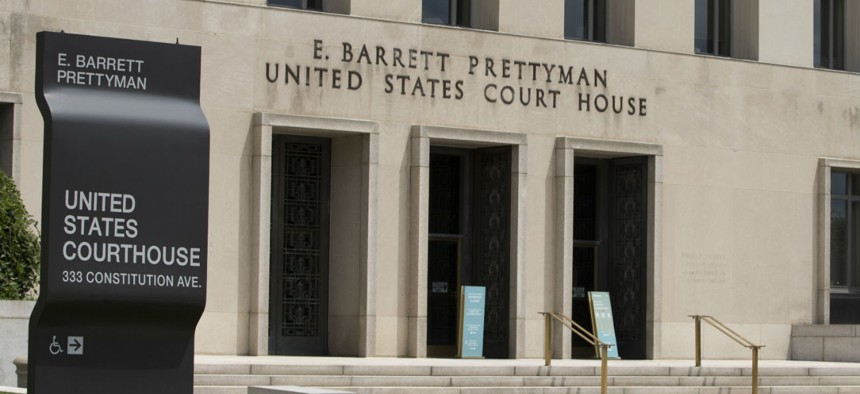
The E. Barrett Prettyman Federal Courthouse that houses the U.S. Court of Appeals for the D.C. Circuit, which ruled against federal unions in the workforce order case. Evan Vucci / AP file photo
Union Challenge to Workforce Orders Could Take Years if Court Doesn’t Reconsider Its Decision
Administrative backlogs and agency vacancies make challenging the orders through three available avenues a daunting task.
When a three-judge panel at the U.S. Court of Appeals for the D.C. Circuit ruled against federal employee unions’ effort to block President Trump’s 2018 workforce executive orders on procedural grounds last week, the court envisioned hearing the merits of the case after unions brought their objections before the Federal Labor Relations Authority.
Experts say that could be easier said than done.
Last week’s circuit court decision found that federal law requires unions to pursue cases related to collective bargaining at federal agencies first through the administrative processes of the FLRA, which adjudicates labor-management disputes and unfair labor practice complaints, and that it was improper to first seek relief from the U.S. District Court.
The three executive orders, signed by President Trump in May 2018, sought to shorten the length of performance improvement plans to 30 days, exempt adverse personnel actions from grievance proceedings, streamline collective bargaining negotiations, and significantly reduce the number of work hours union members can spend on official time.
Union officials argue that Congress did not intend the FLRA, an administrative body whose leadership is appointed by the president, to review the legality of presidential orders related to collective bargaining when it established the agency with the 1978 Civil Service Reform Act. Labor leaders are expected to request a rehearing of the case by all 11 judges on the D.C. Circuit Court sometime in the next six weeks.
Such requests are rarely granted, however. Further, an examination of the machinations of the FLRA suggests that any effort to return to the appellate court under the scheme envisioned by the judges could take months, if not years.
A former employee in the FLRA general counsel’s office said there are essentially three avenues to seek FLRA review of an agency’s actions in collective bargaining negotiations: an unfair labor practice complaint, a negotiability dispute, and some grievance proceedings with an independent arbitrator.
If a union were to file an unfair labor practice complaint, FLRA staff generally would perform an investigation and forward their findings to a regional director at the agency, who would determine whether the complaint had merit. It then would go to the FLRA general counsel, who would choose whether to issue a complaint, at which point the case would go before an administrative law judge for a hearing and adjudication. After the judge issued a decision, both parties would be allowed to file exceptions to the ruling, which would go to the FLRA board for consideration.
“The whole process can take anywhere from six months to two years,” the former employee said.
Since Trump’s inauguration, the FLRA has not had a general counsel, stalling all unfair labor practice complaints. Trump announced his pick for the post, Catherine Bird, earlier this year, and the Senate Homeland Security and Governmental Affairs Committee is slated to vote on her nomination on Wednesday.
Even if Bird is confirmed, unions fear she will choose simply not to issue any unfair labor practice complaints brought by labor groups, although she said during her confirmation hearing that she would be impartial in the role. The former general counsel’s office employee said that it is common for regional directors to seek advice from the general counsel earlier in the investigative process on hot button issues.
“If a case comes into a region that is novel or nationwide or otherwise significant, regional directors, under the authority’s case handling manual, are supposed to send it straight to the general counsel for advice,” the former employee said. “The region is not supposed to make the decision on the complaint.”
Setting aside the unfair labor practice avenue, unions could pursue their legal challenge using one of the two other options, depending on which provisions of the executive orders are at issue. Lawyers for the Trump administration have argued that some elements of the executive orders constitute governmentwide rules, which means agencies no longer have to bargain over them, while others are aspirational goals to strive for in collective bargaining negotiations.
Negotiability disputes, which arise over disagreements over whether a federal agency has a duty to negotiate at all over an aspect of a federal workplace, do not require input from the general counsel before reaching the FLRA board. The FLRA’s most recent decision on a negotiability case was issued in December 2018, nearly 10 months after the union filed its petition for review.
Finally, the union can seek review by alleging a statutory unfair labor practice, like failing to bargain in good faith, during a grievance proceeding with a third-party arbitrator. Although ordinarily the FLRA has the final say when a union or agency appeals an arbitrator’s decision, the law provides an exception when a case involves an unfair labor practice allegation, allowing the case to go to the U.S. Court of Appeals.
But this avenue also might take the longest. Suzanne Summerlin, deputy general counsel at the National Federation of Federal Employees, which is a party to the executive order lawsuit, said the backlog in grievance cases awaiting an arbitrator is already months long—she has cases scheduled for arbitration as late as December 2019. And waiting for the FLRA to weigh in on the appeal of an arbitration decision can take just as long, if not longer.
“I can tell you that I filed exceptions to an arbitration award in early November 2018, and that matter still has not yet been resolved,” Summerlin said. “The authority still hasn’t heard the case.”







